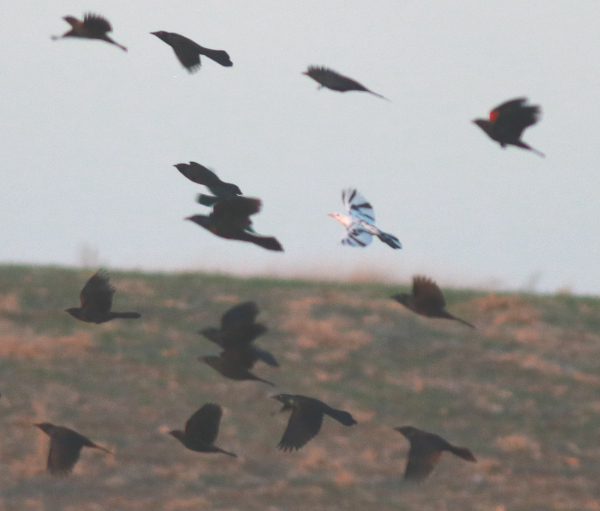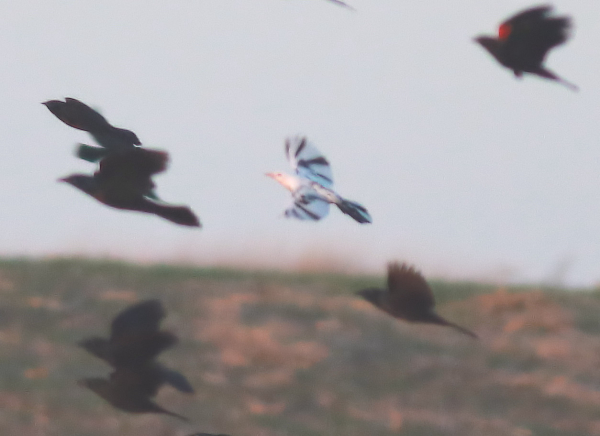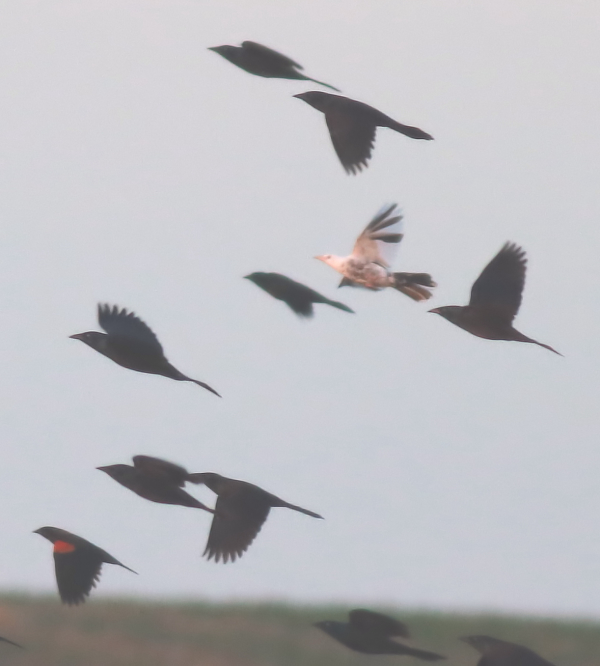Day by day, photo opportunities had been few and far between – literally; I was covering a lot of landscape, looking for any large or small birds along the way without much luck photographically. That was also the case Friday evening as the sun was setting. I was about 8 miles south of my office and about to take a U-turn for home when I noticed a white flash among a large flock of Red-winged Blackbirds and Common Grackles that flushed just above a roadside cattail marsh.

The tiny white flash of a unique partial albino grackle in the midst of a flock of hundreds of black birds initially caught Paul’s attention.
|
I pulled over and re-sighted the white bird in the midst of the flock of black birds flying just above the cattails. I quickly looked with binoculars to make out what looked like a mostly white partial albino grackle! I’ve had the luck of finding a few partial albino birds over the years: a Canada Goose, a couple Ring-necked Pheasants, an American Robin, a couple Blacksmith Plovers (in Africa), a Red-tailed Hawk, a Red-shouldered Hawk, and the first partial albino I found – a Red-winged Blackbird. Now I had a remote chance of documenting a mostly white Common Grackle.
The blackbirds were coming to their night roost, and literally dived into the cattails, only to flush upward and fly low en mass time and time again, repositioning in the cattails with characteristically erratic behavior. The sun was very low and the light was fading, but maybe I could get a documentary photo before the sun slipped behind the hill to the west – it was worth a try.
Low Light Adjustments – To improve my chances of getting any kind of photo in the low light, I increased the ISO setting from 400 to 800. Then dialed the aperture to f5, which would give me the fastest corresponding shutter speed. I also needed to get positioned between the fading sun and the bird, or should I say hundreds and hundreds of blackbirds. As I quickly hustled across the uneven ground along the edge of the cattails, I caught sight of “whitey” a couple times at a distance as birds flushed low in flocks and slipped back into the cattail cover. Once when the blackbirds took flight they repositioned closer to me, in a location where if they flushed again I might have a chance of taking some long-distance photos of the whitish grackle.
Sure enough, in low light with a dark background, a group of blackbirds flushed northward, allowing me to find and try to focus on the partial albino among the throng of black grackles and Red-winged Blackbirds. This time they flew a little higher, breaking the horizon and entering the much brighter sky that I imagined should provide a better chance to get some documentary photos. Thereafter, what seemed like a half-a-thousand blackbirds flushed as if in alarm and flew to some yellow-leaved trees on edge a nearby lake, then began returning to the little cattail stand in flocks of 50 to 100 at a time.

A closer inspection of the documentary digital photos on a full-sized computer screen revealed the details of the mostly white grackle. Note how cropping extraneous outer portions of the photo enlarged the remaining parts of the image. The resulting enlargement created a grainy effect on the photo taken at low light and enlarged much more than you should for other photos.
|
I searched for “whitey” in each flock, but I didn’t relocate it among the now The Birds-like flights undulating around me with a resounding mix of blackbird and grackle calls that approached a low roar above the cattails as I walked back to my vehicle. Seated inside, I took a quick look at the photos I took on the LCD monitor on back of my camera, enlarging the images that might document the unique bird, but they didn’t show much promise. Even so, I knew I could review the digital photos on the larger screen of my office computer to get a better idea of how “whitey’s” plumage looked.
Computer Review – Indeed, when I viewed the photos on my laptop screen – much larger and more detailed than on the camera monitor – I found there were a couple photos that showed pretty good documentation of the unique-looking Common Grackle. Collectively, the photos showed the head, neck, and nape feathers are totally white; its beak is yellow rather than black, and its eyes looked surprisingly pink or pinkish, which is a sign of true albinism. But the grackle retained black feathers here and there; its wings are mostly white with 4 black primary feathers on the left wing and 5 black primaries on the right.
There are a few black feathers on the upper wings, a few more on its back, its belly have some gray feathers, and the tail feathers are mostly black with a couple white feathers mixed in; and its legs and feet are pink. Overall, in the near-dark, from a distance, it looks like a white bird – especially among the other black Common Grackles and Red-winged Blackbirds.
Darkroom Improvements – To show you the best possible documentation photos of this unique bird, taken under very adverse light conditions, and quite a distance away, I transferred a couple of the digital images into my photo editing software in my laptop computer – my modern-day darkroom. First I enlarged one of the two photos I wanted to share with you. Essentially, you enlarge a bird in one photo by cropping the outer extraneous portions of the original image. Next, I brightened the pretty dark cropped photo to try to give the bird and its plumage the most accurate color – as if you took it in good or fairly good lighting.
In retrospect, I think I managed to get as good a set of documentary photos as I could under the poor photo conditions I was dealt. One thing I might have tried would be to up the ISO to 1600, which would have provided a faster shutter speed. However, I was afraid the resulting photos would be too grainy, so I used my experienced judgement, and it worked as well as possible.

A look at the underside of the unique grackle provides a telltale view of more of its plumage. Between the two enlarged documentary photos, it’s clear that your photo equipment can be used to document rare or unusual birds you encounter.
|
Actually, the next evening – Saturday – I returned to the cattail roost to see if the unique grackle would return. As the light was waning, I did use a 1600 ISO setting; and after watching way too many flocks of black birds fly to the cattail roost, the whitish grackle did return, which was exciting in itself. But the one chance I had of taking long-range photos of “whitey” after sunset didn’t make the grade – they were very very poor quality documentary photos – but I enjoyed re-finding the bird nonetheless.
So what makes a photo “documentary”? Obviously, it’s a photo that documents a rare bird find, or it records a bird you have trouble identifying in the field. Often a bird observed under adverse conditions or long distances can be better studied in a still photo, in the manner that I studied the plumage of the partial albino grackle. I would add another aspect to the definition of a documentary photo: It’s a poor quality photo that you take to document your sighting. But if you took the same photo that is sharp with good lighting and bright colors of a bird in a pleasing position and setting, well then it’s a keeper, a fine photo indeed.
I would still like to get more than documentary photos of the unique partial albino grackle; that was my hope Saturday, and I will try again. That’s the kind of interest and drive that keeps us returning to the field, keeps us alert as we are birding in the field, and with an eye on our feeding station and landscaping at home. It’s always a worthy endeavor to take documentary photos of birds, so use your experience and judgment and get that proof positive image that proves you saw what you say you saw – ha-ha. Enjoy all the birds of October!
Article and photographs by Paul Konrad
Share your bird photos and birding experiences at editorstbw2@gmail.com